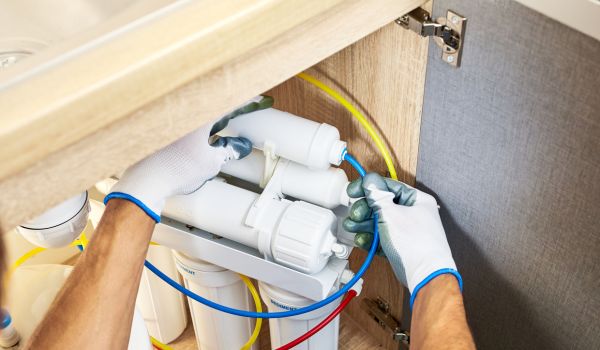If your well water looks cloudy, hazy, or just plain weird — you’re not imagining things. That murky look is called turbidity, and it’s one of the most common complaints from well owners.
Turbidity means your water is full of tiny particles — anything from harmless air bubbles to gritty sediment, or even signs of deeper water quality issues. The good news? Most causes are easy to troubleshoot, and even easier to treat with the right filtration setup.
Let’s break down the top reasons your well water might look foggy — and what you can do to clear it up for good.
⚡ Quick Take
- 🪨 Sediment overload – Dirt, sand, or silt often sneak past your well screen
- 💨 Tiny air bubbles – Can make water look milky but often harmless
- 🧪 Dissolved minerals – Iron, manganese, and other solids can create turbidity
- 🚰 Pump issues or overuse – Can stir up particles, especially in low-water wells
- 🔍 Testing is essential – Cloudy water isn’t always dangerous, but it’s worth checking
🪨 Why Your Water Looks Cloudy

If your tap water looks milky or foggy, you’re likely dealing with turbidity — a fancy term for suspended particles that scatter light and give water a cloudy appearance. It’s one of the most common well water issues — and while it’s not always dangerous, it’s definitely worth a closer look.
Let’s break down the usual suspects behind cloudy water 👇
🧱 1. Sediment
Dirt, rust, and silt can sneak past your well’s sediment screen, especially if it’s worn out or you’re dealing with high sediment levels. Rusty pipes don’t help either — they flake off particles that turn your glass into a gritty mess.
💡 Heads Up: If both hot and cold taps are cloudy or water pressure has dropped, sediment buildup might be clogging your system.
💨 2. Air Bubbles
Tiny air bubbles often get mistaken for sediment — but they usually come from plumbing leaks, pump issues, or dissolved gases in your water.
Try This: Fill a clear glass with water and let it sit for a few minutes. Bubbles will rise and disappear. Sediment will settle at the bottom.
⚠️ Rare Case: Methane in groundwater can also create bubbles — it’s rare, but flammable. If you ever smell gas, call a professional immediately.
🧪 3. Iron or Manganese
Cloudy water with orange or black streaks? That could be excess iron or manganese — or even iron bacteria.
🧫 These microbes feed on iron and leave behind: slimy, rust-colored mess in toilet tanks and pipes. Not harmful, but definitely a nuisance.
👉 If you’re seeing this, check out how to remove iron from well water.
📉 4. Low Water Level
A shallow or over-pumped well can stir up sediment and make water look murky — especially after heavy rain or during drought.
💡 Pro Tip: Low water levels mean your pump is working harder and pulling in more grit. Here’s how long your well pump typically lasts, in case it’s time for a check-up.
💧How to Fix It

Figuring out what’s causing cloudy water is the first step — fixing it is the next. Luckily, there are a few proven ways to clear things up depending on the root cause.
Here’s how to tackle it 👇
🛠️ Step 1: Inspect Your Well System
Before investing in filters or tests, check your well hardware. Common issues like a cracked casing or failing well screen are often behind turbidity.
🔍 Focus your inspection on:
- The well screen (your first sediment defense)
- Casing integrity (even tiny cracks can let in silt)
- The pump and pressure tank (both can introduce air or stir up sediment)
💡 Pro Tip: Not sure where to start? A licensed well contractor can diagnose cloudy water issues quickly — and spot things you might miss.
🧪 Step 2: Test Your Water
Once your well’s hardware checks out, a water test can pinpoint what’s floating around — whether it’s silt, iron, manganese, or something microbial.
🧫 For reliable results, we recommend this well water testing guide, which walks you through what to check for (and how often). For extra peace of mind, the CDC also recommends annual testing for private wells.
💡 Good to Know: A full lab test tells you exactly what kind of filtration you need — no guesswork, no wasted money on the wrong system.
🧼 Filter Options That Work

Sometimes the best way to clear things up is to pair the right problem with the right filter. Here’s a quick guide:
| 🔧 Filter Type | 🌫️ Best For | 💡 Pro Tip |
|---|---|---|
| Sediment Filters | Visible particles like dirt, sand, and silt | Install as a first-stage filter to catch large debris and protect downstream equipment |
| Iron Filters | Rust, orange stains, or metallic taste | Best choice for tackling iron and manganese before they stain fixtures or harm plumbing |
| Whole-House Systems for Wells | Mixed issues (sediment, minerals, and bacteria) | Custom setups designed for well water often include multiple stages for full-spectrum treatment |
💡 Good to Know: If your filter restricts water pressure too much, it might be time to upgrade to a system sized for your household — here’s a look at how filters can affect water pressure.
🧪 Why Water Testing Matters

When your water looks off, testing isn’t just smart — it’s essential. Cloudy water could be caused by sediment, metals, or even bacteria, and the only way to know for sure is to test.
🔍 Why it matters:
Municipal water gets tested daily — but if you’re on a private well, it’s all on you. And cloudy water? That’s your tap waving a little red flag.
🧾 What the CDC Recommends
According to the CDC, private wells should be tested annually for:
- pH
- Total Dissolved Solids (TDS)
- Nitrates
- Coliform bacteria
But if your water’s suddenly cloudy? That calls for a deeper look.
🧪 A Better Testing Option
We recommend the Tap Score Essential Well Water Test Kit — it checks for 52 potential culprits, including:
- Iron
- Manganese
- Sediment-related contaminants
- Plus helpful treatment suggestions based on your results
💡 Pro Tip: Cloudy water is often a symptom, not the problem. Testing helps you zero in on the real cause — so you don’t waste money on the wrong solution.
🛠️ When to Filter (and When Not To)

If cloudy well water is just harmless air bubbles, there’s not much to worry about — it usually clears up on its own. But if sediment, metals, or bacteria are in the mix, filtration goes from optional to essential.
🚫 When It’s Just Annoying
Air bubbles or dissolved gases can make your water look murky — especially in colder climates or if your plumbing has minor leaks. Let a glass sit for a few minutes, and those tiny bubbles will usually rise and vanish. No filter needed.
⚠️ When Filtration Matters
If your water test found iron, sediment, or other cloudiness-causing contaminants, a filter is your best defense.
🔍 Cloudy water might be harmless…
…but it can:
- Scratch up pipes and fixtures
- Shorten appliance life (hello, dishwasher repairs)
- Leave ugly stains in sinks and tubs
💡 Pro Tip: Even minerals like iron and manganese — which aren’t dangerous — can cost you in the long run if they’re not filtered out.
🧠 Final Thoughts
Cloudy well water doesn’t have to mean cloudy answers.
Whether you’re seeing harmless air bubbles or something a bit more stubborn — like sediment, iron, or manganese — the key is understanding what’s in your water so you can treat it properly.
💡 Quick recap:
- If it clears after sitting? Probably air — not a big deal.
- If it sinks or stains? Time to test and filter.
- Not sure? A simple water test clears things up fast.
🚿 Clean, clear water is totally doable. Whether you need a basic sediment filter or a full-on system to tackle iron and other contaminants, there’s a solution that fits your needs (and your water pressure).
 123 people found this helpful. Was this guide helpful to you?
123 people found this helpful. Was this guide helpful to you? 

